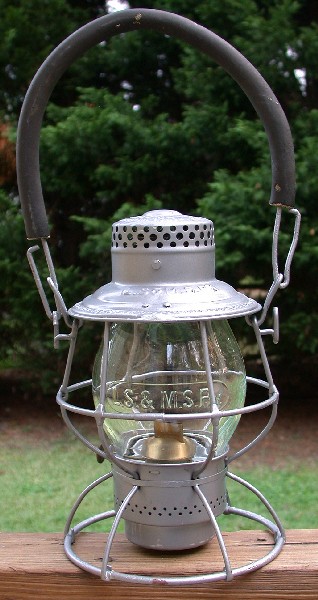

JeffPo's Lake Shore & Michigan Southern Railway Lantern Page
Last update: 11/03/09


This is an Adams & Westlake Reliable lantern from the Lake Shore & Michigan Southern Railway. The lid is stamped with LS&MS Ry. Sometimes you'll find lanterns in which a railroad worker has placed some type of tubing or wrapping on the handle. I assume this was for a better grip for handling. I've noticed it on lanterns from colder regions, which would make sense.

The tall clear globe is cast with LS&MS Ry.. The clear globe was used for general signaling..
Lake Shore & Michigan Southern Railway

Print/drawing of an old LS&MS Ry locomotive.
The Lake Shore and Michigan Southern Railway (LS&MS), sometimes referred to as the Lake Shore, was a major part of the New York Central Railroad's Water Level Route from Buffalo, New York to Chicago, primarily along the south shore of Lake Erie and across northern Indiana.
The LS&MS railway was created in April of 1869, from merges and consolidation of various other railroads such as the Cleveland, Painesville and Ashtabula Railroad (after changing its name to Lake Shore Railway, the Cleveland and Toledo Railroad, and the Michigan Southern and Northern Indiana Railroad. The Erie Railroad was added to the mix in June of 1869. It can really trace its roots back to the Erie and Kalamazoo Railroad, which was chartered in April of 1833.
Around 1877, the New York Central and Hudson River Railroad gained a majority of stock of the Lake Shore and Michigan Southern Railway. The line provided an ideal extension of the New York Central main line from Buffalo west to Chicago, along with the route across southern Ontario (Canada Southern Railway and Michigan Central Railroad). In December 22 of 1914 the New York Central and Hudson River Railroad merged with the Lake Shore and Michigan Southern Railway to form a new New York Central Railroad. In 1968 the New York Central merged with the Pennsylvania Railroad to form the Penn Central Railroad, and in 1976 it became part of Conrail. In 1998 Conrail was split between CSX and Norfolk Southern.
The line is still a major corridor, split at Cleveland by CSX and Norfolk Southern in 1998, and hosts Amtrak passenger trains.

Old postcard of a LS&MS Ry. Depot.
Trivia
The Ashtabula River Railroad Disaster, also called the Ashtabula Horror, was the worst train disaster in American history when it occurred in far northeastern Ohio on 29 December 1876 at 7:28 p.m. The Lake Shore and Michigan Southern Railway Train No. 5, The Pacific Express left a snowy Erie, Pennsylvania on the afternoon of December 29, 1876. As The Pacific Express crossed a bridge over the Ashtabula River, about 100 yards from the railroad station at Ashtabula, Ohio, the passengers heard a terrible cracking sound. In just seconds, the bridge fractured and the train plunged 70 feet into the ravine. One locomotive and eleven railcars went off the bridge. The disaster was compounded by the raging fire that broke out because of the stoves and lamps (remember the cars were wooden). Of 159 passengers and crew onboard that night, 64 people were injured and 92 were killed or died later from injuries. It is unclear how many died of the fall, or drowning separate from the blaze. The disaster helped focus efforts to draw up standards for bridges including adequate testing and inspection.